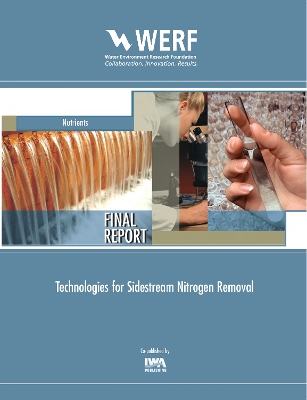WERF Research Report
2 total works
NUTR1R06w
Technologies for Sidestream Nitrogen Removal
by Gregory Bowden, David Stensel, and Ryujiro Tsuchihashi
Published 15 March 2016
Liquid streams ("reject water" or "sidestream") generated by the dewatering of digested solids generally contain high levels of ammonia and phosphorus. These liquids can be treated in separate or sidestream processes rather than being directly returned to the mainstream treatment process. Sidestream treatment processes can reduce overall energy and chemical costs and improve treatment reliability for biological nutrient removal facilities. Sidestream treatment processes can also be used for nutrient recovery and reuse.
This document is a compilation of a broad range of biological and physiochemical treatment processes specifically for nitrogen removal and recovery from municipal sidestreams and ammonia-rich industrial wastewaters. The benefits of these technologies are described along with design approaches and full-scale plant experiences. Reuse of recovered ammonia in the form of aqueous ammonia and ammonium salts for industrial and agricultural applications is also discussed. Future research needs in sidestream nitrogen removal and recovery are identified and summarized.
This document is a compilation of a broad range of biological and physiochemical treatment processes specifically for nitrogen removal and recovery from municipal sidestreams and ammonia-rich industrial wastewaters. The benefits of these technologies are described along with design approaches and full-scale plant experiences. Reuse of recovered ammonia in the form of aqueous ammonia and ammonium salts for industrial and agricultural applications is also discussed. Future research needs in sidestream nitrogen removal and recovery are identified and summarized.
NUTR1R06y
Long Island Sound was designated as an "estuary of national significance" in 1998, and the Long Island Sound Study (LISS) was directed to develop a comprehensive conservation and management plan (CCMP) for protecting and enhancing the water quality and health of the Long Island Sound. A reduction of 58.5% of the nitrogen load from point and non-point sources within 15 years (by 2014) as measured against the 1990 base load was adopted by the CCMP. To administer and enforce the nitrogen reduction target, the Connecticut Department of Environment Protection (CT DEP) in conjunction with the LISS and U.S. EPA developed a total maximum daily load (TMDL) in 2001. To achieve the TMDL goals, the CT DEP developed a nitrogen trading program among 79 wastewater treatment plants located throughout the state, and established the Nitrogen Credit Advisory Board (NCAB) and the Nitrogen Credit Exchange (NCE) Program in 2002.
In 2008, the NCAB proposed funding for the purchase of online or portable analyzers for DO and nitrogen, up to $40,000 for each wastewater treatment plant, to improve BNR process control. The total funding recommended by NCAB was $1,966,500. The study presented in this report summarized the use of online analyzers by water pollution control facilities (WPCFs) in Connecticut, and considerations for the use of online analyzers for automated process control are discussed. Case studies from the wastewater treatment facilities in Connecticut were provided, which sheds light on the practical approaches towards automated online process control for the improvement of BNR process performance.
WERF Report: NUTR1R06y
There are many interrelated connections between the environment and zoonotic diseases such as: water, soil, air and agriculture.
The book presents investigations of these connections, with specific reference to environmental processes such as: deforestation, floods, draughts, irrigation practices, soil transfer and their impact on bacterial, viral, fungal, and parasitological spread.
Environmental aspects such as climate (tropical, sub-tropical, temperate, arid and semi-arid), developed and undeveloped countries, animal (domestic and wild) traffic animal border crossing, commercial animal trade, transportation, as well geography and weather on zoonosis, are also discussed and relevant scientific data is condensed and organized in order to give a better picture of interrelationship between the environment and current spread of zoonotic diseases.
Altogether, the book presents a remarkable and a vast amount of potential future research directions based on the link: environment-vectors-pathogens-humans.
The most up-to-date source of information on this increasingly important cross-disciplinary subject, Environmental Aspects of Zoonotic Diseases will be invaluable for environmentalists, veterinarians, medical staff, environmental engineers, government agencies and consultants working in this field.
In 2008, the NCAB proposed funding for the purchase of online or portable analyzers for DO and nitrogen, up to $40,000 for each wastewater treatment plant, to improve BNR process control. The total funding recommended by NCAB was $1,966,500. The study presented in this report summarized the use of online analyzers by water pollution control facilities (WPCFs) in Connecticut, and considerations for the use of online analyzers for automated process control are discussed. Case studies from the wastewater treatment facilities in Connecticut were provided, which sheds light on the practical approaches towards automated online process control for the improvement of BNR process performance.
WERF Report: NUTR1R06y
There are many interrelated connections between the environment and zoonotic diseases such as: water, soil, air and agriculture.
The book presents investigations of these connections, with specific reference to environmental processes such as: deforestation, floods, draughts, irrigation practices, soil transfer and their impact on bacterial, viral, fungal, and parasitological spread.
Environmental aspects such as climate (tropical, sub-tropical, temperate, arid and semi-arid), developed and undeveloped countries, animal (domestic and wild) traffic animal border crossing, commercial animal trade, transportation, as well geography and weather on zoonosis, are also discussed and relevant scientific data is condensed and organized in order to give a better picture of interrelationship between the environment and current spread of zoonotic diseases.
Altogether, the book presents a remarkable and a vast amount of potential future research directions based on the link: environment-vectors-pathogens-humans.
The most up-to-date source of information on this increasingly important cross-disciplinary subject, Environmental Aspects of Zoonotic Diseases will be invaluable for environmentalists, veterinarians, medical staff, environmental engineers, government agencies and consultants working in this field.

